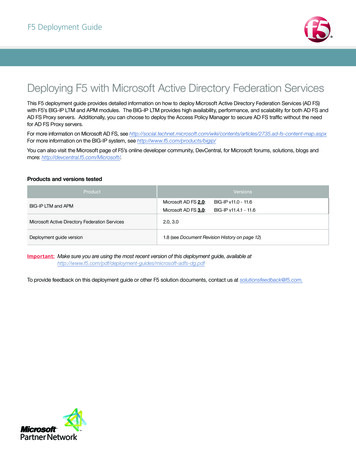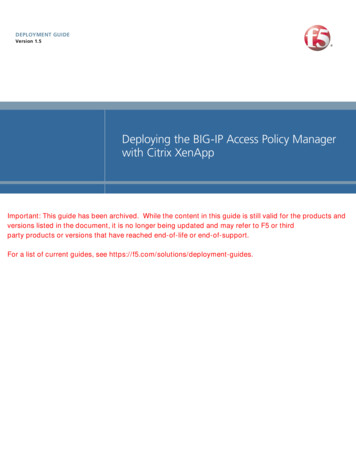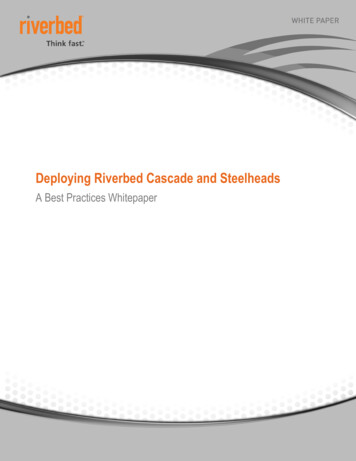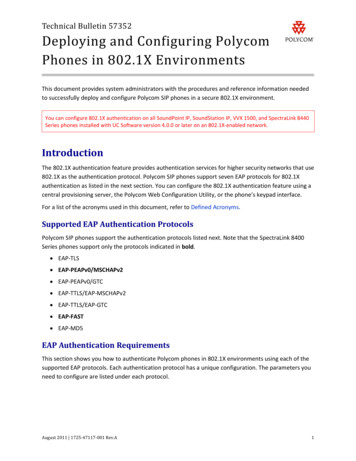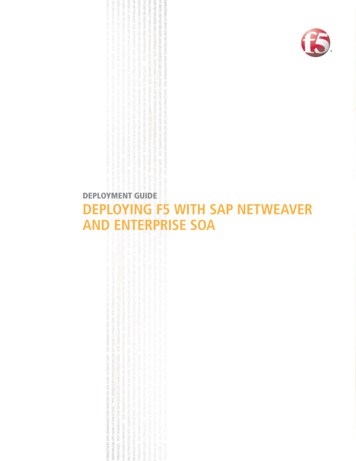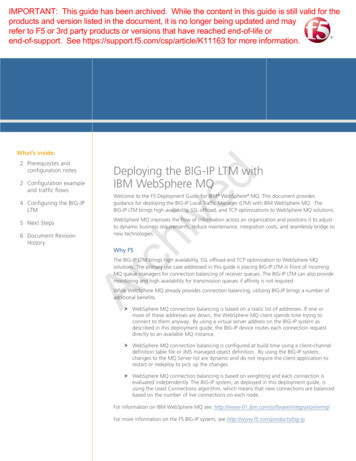
Transcription
IMPORTANT: This guide has been archived. While the content in this guide is still valid for theproducts and version listed in the document, it is no longer being updated and mayrefer to F5 or 3rd party products or versions that have reached end-of-life orend-of-support. See https://support.f5.com/csp/article/K11163 for more information.What’s inside:2 Configuration exampleand traffic flows4 Configuring the BIG-IPLTM5 Next Steps6 Document RevisionHistoryDeploying the BIG-IP LTM withIBM WebSphere MQchived2 Prerequisites andconfiguration notesWelcome to the F5 Deployment Guide for IBM WebSphere MQ. This document providesguidance for deploying the BIG-IP Local Traffic Manager (LTM) with IBM WebSphere MQ. TheBIG-IP LTM brings high availability, SSL offload, and TCP optimizations to WebSphere MQ solutions.WebSphere MQ improves the flow of information across an organization and positions it to adjustto dynamic business requirements, reduce maintenance, integration costs, and seamlessly bridge tonew technologies.Why F5ArThe BIG-IP LTM brings high availability, SSL offload and TCP optimization to WebSphere MQsolutions. The primary use case addressed in this guide is placing BIG-IP LTM in front of incomingMQ queue managers for connection balancing of receiver queues. The BIG-IP LTM can also providemonitoring and high availability for transmission queues if affinity is not required.While WebSphere MQ already provides connection balancing, utilizing BIG-IP brings a number ofadditional benefits.hh W ebSphere MQ connection balancing is based on a static list of addresses. If one ormore of these addresses are down, the WebSphere MQ client spends time trying toconnect to them anyway. By using a virtual server address on the BIG-IP system asdescribed in this deployment guide, the BIG-IP device routes each connection requestdirectly to an available MQ instance.hh W ebSphere MQ connection balancing is configured at build time using a client-channeldefinition table file or JMS managed object definition. By using the BIG-IP system,changes to the MQ Server list are dynamic and do not require the client application torestart or redeploy to pick up the changes.hh W ebSphere MQ connection balancing is based on weighting and each connection isevaluated independently. The BIG-IP system, as deployed in this deployment guide, isusing the Least Connections algorithm, which means that new connections are balancedbased on the number of live connections on each node.For information on IBM WebSphere MQ see: http://www-01.ibm.com/software/integration/wmq/For more information on the F5 BIG-IP system, see http://www.f5.com/products/big-ip
DEPLOYMENT GUIDEIBM WebSphere MQProducts and versions testedProductVersionBIG-IP LTM11.1 HF-2IBM WebSphere MQ7.1Important: M ake sure you are using the most recent version of this deployment guide, found phere-mq-dg.pdf.To provide feedback on this deployment guide or other F5 solution documents, contact us atsolutionsfeedback@f5.com.chivedPrerequisites and configuration notesThe following are general prerequisites and configuration notes for this guide:hh I f you are using the BIG-IP system to offload SSL, we assume you have already obtained anSSL certificate and key, and it is installed on the BIG-IP LTM system.hh A s stated in the introduction, the primary use case in this deployment guide is theBIG-IP system deployed in front of queue managers, providing load balancing and offload.hh W ebSphere MQ heartbeats should be configured to a value smaller than the BIG-IP LTMTCP Idle Timeout value. We recommend 180 seconds for the BIG-IP LTM TCP Idle Timeoutvalue (as shown in this guide) and 60 seconds for the WebSphere MQ heartbeat value. Forinformation on configuring the WebSphere MQ heartbeats, see the IBM documentation.ArConfiguration example and traffic flowsUsing the configuration in this guide, the BIG-IP system provides high availability directly toWebSphere Message Broker Servers. If DataPower XI50 devices are used for XML transformation inyour implementation, the BIG-IP provides high availability to the DataPower devices.The traffic flows for each of the modes, and configuration instructions are below. The setup ofBIG-IP is currently identical between the two modes, but the setup of WebSphere MQ is differentbetween the two modes.Mode 1 - BIG-IP LTM directing traffic to WebSphere MQIn the following diagram, the BIG-IP LTM provides intelligent traffic direction and high availabilityfor WebSphere Message Broker servers.WebSphere Message Broker Server 1Broker 1Broker 2ServersQueue 11Queue 22BIG-IP LTM3Broker 3Broker 4Queue 1Queue 2WebSphere Message Broker Server 22WebSphere ApplicationServer Cluster
DEPLOYMENT GUIDEIBM WebSphere MQ1. The BIG-IP system continually monitors the WebSphere MQ servers for health and availability.2.T he BIG-IP system accepts incoming queue messages and delivers them to the appropriateBroker server.3. Outgoing queues may return without traversing the BIG-IP LTM.Configuring WebSphere MQ devices for use with the BIG-IP systemTo provide high availability for WebSphere MQ, you must have two or more identical WebSphereMessage Broker Servers. For example, you should setup the exact same transmission queues,Queue Managers and Channels on all MQ servers, using the same TCP ports and names for allservers. For specific instructions, see the IBM documentation.chivedMode 2 – Load balancing DataPower DevicesIn the following diagram, the BIG-IP LTM provides intelligent traffic direction and high availability tothe DataPower devices.WebSphere Message Broker Server 1Broker 1DataPowerBroker 2ServersQueue 1123BIG-IP LTMQueue 245WebSphere ApplicationServer ClusterBroker 3Broker 4DataPowerQueue 1Queue 2WebSphere Message Broker Server 2ArThis diagram illustrates the following process:1.T he BIG-IP LTM receives all incoming requests and distributes these requests across theDataPower XI50 appliances.2.T he DataPower devices perform basic validation and threat protection on the SOAP requests.It also load balances the requests to the WebSphere Message Broker servers in the network.3.E ach broker contains two execution groups running an instance of the message flow. Thisresults in eight instances of the same message flow. DataPower load balances across theseeight endpoints.4.The message flow writes the message to a WebSphereMQ queue.5.The message is consumed by a MDB connected to WebSphereMQ using client bindings.The high availability features of the topology are as follows:3 If a DataPower device becomes unavailable, traffic can be routed to an alternate device. I f one WebSphere Message Broker server becomes unavailable, all traffic is routed to thealternate server. If one or more brokers becomes unavailable, all traffic is routed to the remaining brokers I f one or more execution groups becomes unavailable, all traffic is routed to the remainingexecution groups.
DEPLOYMENT GUIDEIBM WebSphere MQRelationship between MQ queue managers and BIG-IP virtual server addressesIn the following chart, we demonstrate the relationship between MQ queue managers, Port and IPinformation for that queue manager, and the BIG-IP virtual server. In this example, there are threequeue managers, SalesQueue, OrderQueue and InventoryQueue, installed on two MQ Servers,192.168.10.50 and 192.168.10.60. The queue managers are each mapped on a specific port onthe server, in this case, 1414, 1415 and 1416. On the BIG-IP LTM, virtual servers are configured foreach queue manager on the same TCP port, but in our case with external routed IP addresses. TheBIG-IP LTM pool contains the two MQ servers and monitors these servers for health and availabilitybefore delivering message traffic. By separating queue managers on their own ports, persistenceand grouping of messages can be managed on a more granular level, with more visibility into thehealth of each server.MQ Queue ManagerBIG-IP virtual server192.168.10.50:1414 and 192.168.10.60:141464.0.0.1:1414chivedSalesQueue managerQueue Manager (IP:Port)192.168.10.50:1415 and 192.168.10.60:141564.0.0.1:1415InventoryQueue manager192.168.10.50:1416 and 192.168.10.60:141664.0.0.1:1416ArOrderQueue manager4
DEPLOYMENT GUIDEIBM WebSphere MQConfiguring the BIG-IP LTMUse the following table for guidance on configuring the BIG-IP LTM for either deployment mode.This table shows the required BIG-IP configuration objects with any non-default settings youshould configure as a part of this deployment. Unless otherwise specified, settings not mentionedin the table can be configured as applicable for your configuration. For specific instructions onconfiguring individual objects, see the online help or product manuals.As described in the following table, you need to create a BIG-IP pool and virtual server for eachtransmission queue that is a part of this deployment. For instructions onImportantThe heartbeat value in your WebSphere MQ configuration must be less than the BIG-IP LTM IdleTimeout value in the TCP configuration. We recommend a WebSphere MQ heartbeat value of 60seconds. See the WebSphere documentation for specific instructions on configuring the heartbeat.chivedIt is critical that a tcp half open monitor be used, in order to minimize impact on the WebSphereMQ server. If a full TCP monitor is used, WebSphere MQ generates a dump file and may degradethe performance of the queue manager over time.BIG-IP ObjectNon-default settings/NotesHealth MonitorNameType a unique name(Main tab-- Local Traffic-- Monitors)TypeTCP Half OpenNameType a unique namePool (Main tab-- LocalTraffic -- Pools)Health MonitorSelect the monitor you created aboveSlow Ramp Time1300Load Balancing MethodChoose Least Connections (Member)AddressType the IP Address of a WebSphere MQ nodeService PortType the appropriate port for the channel, such as 1414.Repeat Address and Service Port for all nodes)ArCreate additional pools for each Receiver Queue be load balanced. Use the appropriateService port for the specific Receiver Queue.Profiles(Main tab-- Local Traffic-- Profiles)TCP WAN(Profiles-- Protocol)TCP LAN(Profiles-- Protocol)Client SSL(Profiles-- SSL)2Server SSL(for SSL Bridging only)(Profiles-- SSL)NameParent Profiletcp-wan-optimizedIdle Timeout 2180 2NameType a unique nameParent Profiletcp-lan-optimizedIdle Timeout 2180 2NameType a unique nameParent ProfileclientsslCertificateSelect the Certificate you importedKeySelect the associated KeyNameType a unique nameParent ProfileIf your server is using a certificatesigned by a Certificate Authority, selectserverssl.If your server is using a self-signedcertificate, or an older SSL cipher, selectserverssl-insecure-compatible.Certificate and KeyLeave the Certificate and Key set to None.312345Type a unique nameYou must select Advanced from the Configuration list for these options to appearSee important note above this table. The WebSphere MQ heartbeat value must be less than this Idle Timeout value.A Client SSL profile is only necessary if you want the BIG-IP system to decrypt SSL connections, typically for SSL Offload. The Server SSL profile is only necessary if you require encrypted traffic all the way to the servers. For SSL Offload(recommended), you do not need a Server SSL profile.
DEPLOYMENT GUIDEIBM WebSphere MQBIG-IP ObjectNon-default settings/NotesNameType a unique name.AddressType the IP Address for this virtual serverService PortProtocol Profile (Client)Virtual Server(Main tab-- Local Traffic-- Virtual Servers)Type the same port you used for the pool, such as 1414.1,4Select the WAN optimized TCP profile you created aboveProtocol Profile (Server) 1Select the LAN optimized TCP profile you created aboveSSL Profile (Client) 2If you created a Client SSL profile only: Select the Client SSLprofile you created aboveSSL Profile (Server) 3If you created a Server SSL profile for SSL Bridging only: Selectthe Server SSL profile you created above.SNAT PoolAuto MapDefault PoolSelect the appropriate pool you created abovechivedCreate additional virtual servers for each pool you created above. Make sure to use theappropriate Service Port, and select the appropriate Pool. You can use the same profiles.1234You must select Advanced from the Configuration list for these options to appearA Client SSL profile is only necessary if you want the BIG-IP system to decrypt SSL connections, typically for SSL Offload. The Server SSL profile is only necessary if you require encrypted traffic all the way to the servers. For SSL Offload(recommended), you do not need a Server SSL profile. If the majority of your clients are connecting via a LAN, use the LAN optimized profile you created.This completes the BIG-IP LTM configuration.Next StepsArNow that you’ve completed the BIG-IP system configuration for IBM WebSphere MQ, here aresome examples of what to do next.Adjust your DNS settings to point to the BIG-IP systemAfter the configuration is completed, your DNS configuration should be adjusted to point to theBIG-IP virtual server for WebSphere MQ.Advertise new Queue IP addresses to Messaging systems.You must advertise your new Queue IP addresses to your Messaging Systems. Be sure to updateyour transmission queues to point to the BIG-IP LTM virtual IP address or the DNS name you havecreated for this address.If you do not advertise the IP addresses, traffic is sent directly to the broker servers and not the highavailability system you have just created.Make sure the BIG-IP TCP Idle Timeout is configured properlyIf you notice your WebSphere Queues are timing out, check to make sure you the WebSphere MQheartbeat are set to a value that is smaller than the BIG-IP TCP Idle Timeout value, as described inthis guide on page 5 .6
7DEPLOYMENT GUIDEIBM WebSphere MQDocument Revision HistoryVersion1.0DescriptionNew guideDate06-13-2012- Added new content to the Why F5 section on the first page- Changed references to “MQ queues” to “MQ queue managers”1.1- Modified the parent
MQ queue managers for connection balancing of receiver queues. The BIG-IP LTM can also provide monitoring and high availability for transmission queues if affinity is not required. While WebSphere MQ already provides connection balancing, utilizing BIG-IP brings a number of additional benefits. h WebSphere MQ connection balancing is based on a static list of addresses. If one or more of these .

